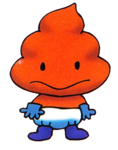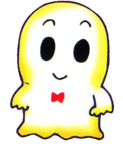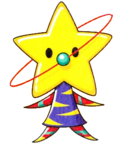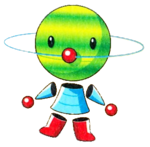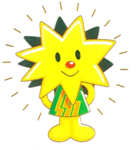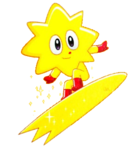Sanrio Wiki has moved from ShoutWiki. Account creation is closed to prevent spam. This wiki is independently run by EvieMelody and users who had previously made an account from now on. Progress has been slow due to illness and the lack of a laptop.
Note: Sanrio Wiki is not official and is not run by Sanrio Co., Ltd. or related parties. This wiki uses some low resolution content (images, short sound clips) to describe articles, under fair use (for the purpose of illustrating and describing an article only). All rights are reserved by Sanrio and related parties.
Sometimes this wiki may be a little slow, other times it is faster. This is likely server related. On such days, you may want to stockpile edits offline for later.
See also: Sanrio Wiki:COPPA
Sanrio Timenet: Kako-Hen and Mirai-Hen
| Sanrio Timenet: Kako-Hen and Mirai-Hen | |
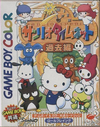 
| |
| Developer(s) | Imagineer (Timenet) |
| Publisher(s) | Imagineer |
| Director(s) | Imagineer: Motoaki Tanigou, HOLON: Sakuramaru Yamada, CROSS) |
| Producer(s) | Hidenori Ueno (Imagineer) |
| Composer(s) | Jirou Koumoto |
| Release date(s) | (Nintendo Power cartridge service) |
| Genre | Role-playing game (monster battling) |
| Platform(s) | Game Boy Color |
| Player mode(s) | 1-2 players (communication e.g. battling) |
| Serial code(s) | DMG-ATPJ-JPN (Kako-Hen), DMG-ATFJ-JPN (Mirai-Hen) |
(Context: Some of the dangerous notice is concerning the manga, not the games themselves. However, some of the Monsters learn moves based on blood, such as Blood Gas)
Sanrio Timenet (Japanese: サンリオタイムネット) is a monster-battling game developed by Imagineer for the Game Boy Color, which is also compatible with the Game Boy. It was released only in Japan on November 27, 1998.
It was released in two editions, named Sanrio Timenet: Kako Hen (Japanese: 過去編) and Sanrio Timenet: Mirai Hen (Japanese: 未来編); literally Sanrio Timenet: Past and Present Edition.
There are small differences between the versions, including different available monsters and each version being originally set in its respective time periods (past for Kako-Hen or future for Mirai-Hen).
Players build up a team of creatures ("monsters"), often by catching them using items known as Get Cards (or later in the story, a Digital Camera) and use them to battle against other creatures.
The games support the Game Boy Game Link Cable; which can be used to battle with other players and exchange information. Pictures of monsters and Sanrio characters met in the game can be printed using the Game Boy Printer.
According to an insert with Pocket Hello Kitty, a Nintendo 64 entry in the series called Sanrio Timenet World was planned but never released.[1]
Story
Time was flowing properly in the world of Timenet, the home of the Old Man of Time, thanks to the Pillar of Time which is responsible for the flow of the past, the present and the future. However, due to the work of someone, the Pillar of Time was broken into small pieces and the world was divided into the past and the future.
The protagonist receives an email from the Old Man of Time, who explains the situation and requests that he or she helps save the world of Timenet by collecting the Time Fragments, before the flow of time is permanently lost.
This game features a hero and rival and at the beginning of the game the player can either choose a male or female hero as the protagonist. The other character will act as the rival.
The rival will race the player to change the world of Timenet back to its original state, and will act as the player's rival at various points in the game. Soon after, the Old Man of Time takes the player to the world of the past (Kako Hen) or future (Mirai Hen). For some reason, the protagonist can hear a girl exclaim "help me" while travelling...
Locations
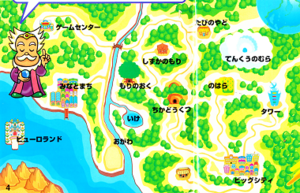
Main
The following locations are areas that can be accessed both with by foot/bicycle and by the Earth Watch — a late game item that allows warping.
|
Dungeons
|
Other locations
|
Gameplay
As either a male or female character, the player travels the world of Sanrio Timenet battling with monsters. On their adventure, they will encounter many Sanrio characters; some who are important to the story. Some Sanrio characters will battle the player with monsters, and at the end of the battle the player gets to select one of the enemy monsters to keep.
The goal of the games is to help save the world before the flow of time is permanently lost. The player must fill up the Pillar of Time to 100% by collecting 161 monsters. The player can also collect special watches. The monsters do not have to be unique to fill the Pillar of Time.
In their quest, the player must travel to the future (Kako Hen) or the past (Mirai Hen) but after beating the game, they can no longer time travel. Depending on whether the player is in the past or the future, the names of places are different as well as monsters and which characters appear.
Near the end of the game, the player finds out the identity of the villain who destroyed the Pillar of Time and confronts her on Mars.
Bodyguards
At the beginning of the games, the player has a choice of one of three starting monsters ("bodyguards") at level 1. The available bodyguards differ between Kako-Hen and Mirai-Hen.
In Kako-Hen
In Mirai-Hen
Illusory monsters
Illusory monsters are monsters in Sanrio Timenet: Kako Hen and Mirai Hen that cannot be obtained normally in game without an official distribution or a cheating device.
Packaged with the games was a 'campaign' sheet where players could send for the illusory monster Stardust. The illusory monster Time Surfer can be seen after the splash screens before the title screen.
Character list
Sanrio Timenet: Kako Hen and Mirai Hen have a "character data" menu which documents the roles of Sanrio characters as they appear in the games. The list is as follows.
Hangyodon notably does not appear, but he was included as a rare monster in Mars Tower, and he has two evolutions; Great Hangyo and Hangyodon Robo. He is one of the only first-party Sanrio characters to appear as a monster and not a regular character, another is Gerara.
|
Monsters
Please see List of monsters in Sanrio Timenet: Kako Hen and Mirai Hen for a list of monsters.
Sanrio Timenet: Kako Hen and Mirai Hen feature 161 collectible monsters, as well as event monsters known as Monster Zakki and White Zakkī who may be unobtainable.
Unlisted characters
- Male protagonist - This character (the other option being the female protagonist) can either be the main protagonist or rival and is named by the player. As the primary protagonist, he received an email from the Old Man of Time explaining the crisis in his world. As the rival, he races the player to change the world of Timenet back to its original state. He is a brown haired boy (although his sprite has a green palette in the game) with a helmet who wears a blue shirt and has blue roller blades.
- Female protagonist - See above. She is a brown haired girl with a helmet who wears a pink shirt and has pink roller blades.
- Hello Kitty - Hello Kitty runs second hand shops in various places. She can also be found in an inn north-east of Camp Place, where she heals the player.
- Nurse Kitty - Nurse Kitty runs recovery centers in various places.
Staff credits
HOLON
Director: CROSS
Scenario: Sakuramaru Yamada
Inspace
Character Design: Hisato Inoue
Sanrio
Executive Producer: Shintarou Tsuji
Graphics Adviser: Yuuko Sakiyama
Imagineer
Executive Producer: Takayuki Kamikura
Supervisor: Seiji Tashiro
Producer: Hidenori Ueno
Product Manager: Keiko Ishikawa
Director: Motoaki Tanigou
Sales Manager: Nobuhiro Nakano, Yoshikazu Watanabe
Marketing Manager: Kaichirou Mitsuzawa
Promotion Manager: Tadashi Horikiri
Advertising: Junichi Matsumoto
Programmer: Masaki Hirao, Tetsuya Motoyama
Graphics Designer: Chinaō Seki, Yoshio Tanaka, "Gyouten", "Umiumi", "Kenni"
Music Composer: Jirou Koumoto
Coordinator: Katao Rinokata, Shin Yama
Coordination Support: Jun Hayashi
Monitor: Anko Kamiya, Miko Ootsuno, Matakichi Senkou
duplex inc.
Package Design: Shigenari Douzono
Special Thanks
Yuuko Mori, Yasushi Kamegai, "Everyone who gave us Hello Kitty"
Unlisted
- Katsutoshi Fujioka (official artwork pertaining to the games)
Manga
- Main article: Bouken Jikuu Timenet.
| CAUTION: The following article has received the safety notice. For more information on why this may have received the notice, see Category:Articles which received the safety notice. |
A Japanese manga series based on Sanrio Timenet without first-party Sanrio characters known as Bouken Jikuu Timenet (literally "Adventure Space-Time Timenet") was produced by Sakuramaru Yamada with illustrations by Hiroshi Soya. It was serialized in Shogakukan's "Elementary School Fifth Grade" and "Elementary School Sixth Grade" magazines starting from 1999. The manga was collected in two booklets (tankōbon).
Bouken Jikuu Timenet is notable for its 'off-color humour' that many may find offensive, abusing themes including blood, nudity (censored) and near-death experience.
The manga features the protagonists Tōru and Ēru. Tōru and Ēru are based on the male and female primary protagonists of Sanrio Timenet, respectively.
The manga is copyrighted to Timenet, a subsidiary of Imagineer.
Trivia
| Note: This article contains information which has been already leaked; violating a non-disclosure agreement or pertaining to theft. The founder asserts in her opinion while documenting a past leak (with strictly no personal details) over two years old is good for transparency and a full representation of Sanrio-related themes, any other use (or accessing the leak itself for copyrighted media) is illegal. If you are the copyright owner and want to leave a message (such as taking down content) please see the contact information here. |
- The game prevents the player from naming the rival the same name as the protagonist.
- Due to a glitch, the Jetboat item may be unusable when accessing the event items by pressing Select from the Start screen. A sure way to use it is by accessing the event items list by instead pressing B from the overworld.
- A fan translation of Sanrio Timenet: Mirai Hen was started but never finished. The translation is not accurate to the original text.
- Tose; a "ghost developer" said to have contributed in the development of over 1000 video games is assumed by some to have been involved in the development of the games. Sound effects in this game are shared by titles such as TOSE's Densetsu no Starfy for Game Boy Advance. In TOSE's 2001 corporate guide there is a large picture of games with their box-arts obscured. One of the games is believed[2] by GDRI (a small video game development research community) to be Sanrio Timenet: Mirai-Hen. However, there is no confirmation.
- There are two hidden revisions of the games, v1.0 and v1.1 (also known as Rev 1). Rev 1 fixes the above Jetboat item glitch.
- Both versions could also be installed on a Game Boy Memory Cartridge (via the Nintendo Power cartridge service) starting from May 1, 2000. However, Nintendo's official page "Role-playing software for Game Boy: 2" stopped listing it some time after August 25, 2005 (May 20, 2006 or earlier).[3][4] Until August 31, 2001, games were written on the cartridge using a Game Kiosk writer at Lawson convenience stores in Japan. After this, Game Boy Memory Cartridges had to be sent into Nintendo. However, for the latter it is not clear if Nintendo accepted this game. Nintendo Power was fully terminated on February 28, 2007.
See also
- Space-Net: Cosmo Red and Cosmo Blue
- Attribute (Sanrio Timenet)
- List of moves in Sanrio Timenet: Kako-Hen and Mirai-Hen
- List of items in Sanrio Timenet: Kako-Hen and Mirai-Hen
- Soundtrack of Sanrio Timenet
- Sanrio Timenet: Kako-Hen and Mirai-Hen (reverse engineering data)
External links
- Mini-site on Imagineer's official website (Wayback Machine capture as of February 11, 2003)
- Japanese Sanrio Timenet wiki.
- Japanese Wikipedia article.
References
- ↑ YouTube video by Elliot Coll
- ↑ The Strength of Tose - Flickr
- ↑ ゲームボーイ用のロールプレイング系ソフト (Archived from the original on August 25, 2005 via Wayback Machine). Via Japanese Wikipedia editors on 「ニンテンドウパワーのゲームタイトル一覧」の変更履歴 article.
- ↑ ゲームボーイ用のロールプレイング系ソフト:2 (Archived from the original on May 20, 2006 via Wayback Machine).

